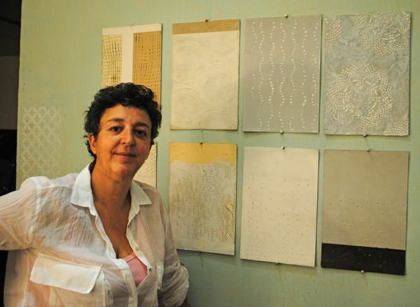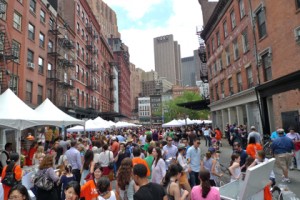Categories
Left column house ads
From Paris to Tribeca
August 31, 2011 People
 French native Sylvie Michel Bilger arrived in New York in 1986. She was a young decorative painter in her twenties, fresh off a renovation project at the famed Palace of Versailles. Armed with nothing more than the name of a local friend of a friend, she managed to carve out a life for herself. One husband, two children, and 25 years later, she is still happily living and working in Tribeca. She sat down with us at her loft, which she’s been living in since 1987, and discussed her life in the U.S., Metamorfaux (the company she and her husband run together), and what it’s really like to work with celebrities. Portrait by Noemi Bilger.
French native Sylvie Michel Bilger arrived in New York in 1986. She was a young decorative painter in her twenties, fresh off a renovation project at the famed Palace of Versailles. Armed with nothing more than the name of a local friend of a friend, she managed to carve out a life for herself. One husband, two children, and 25 years later, she is still happily living and working in Tribeca. She sat down with us at her loft, which she’s been living in since 1987, and discussed her life in the U.S., Metamorfaux (the company she and her husband run together), and what it’s really like to work with celebrities. Portrait by Noemi Bilger.
What is a decorative painter exactly?
I work on interiors, doing things like wall treatments and textured finishes.
You honed your skills at the Palace of Versailles?
Well, I have an academic art background and studied decorative painting at the Van Der Kelen Academy in Brussels. But yes, one of my first projects was at the Palace of Versailles. We restored a wing, and I worked on the painting and wainscoting. It was painstaking, detailed work and I was there for two years.
What made you decide to come to the U.S.?
In Paris, everyone wants to come to New York. Everyone loves the U.S. and American influences, like the music. After my project in Versailles was over, I decided it was a good time to try living in the U.S.
Was it difficult for you in the beginning?
The language was certainly a problem. I barely spoke English. I had learned it in school, but I was a few years out at that point. Plus, we learned English with a British accent. It took some time to understand Americans.
Was it difficult to make friends?
I was very lucky in that regard. At Versailles, I got to know Robert Polidori, who is now a famous photographer, known for his work in New Orleans after Katrina. When he heard I was moving to New York, he gave me the name of a friend of his here. Through that friend, I met a whole circle of artists.
Was it difficult to find work?
I think the fact that I had a craft opened up a lot of doors for me. I ended up doing a mural for Isabella Rossellini at the American Thread Building. She was collecting circus art at the time, and she commissioned a monkey triptych from me. I’ll never forget the day I opened up House & Garden magazine and saw a picture of my monkeys in a story on Isabella’s apartment.
So it was a pretty easy transition to life in New York?
Not exactly. I had almost no money when I moved here. I survived on one Blimpie sandwich a day back then.
Did you think about moving back?
No, never. As I said, I had a good circle of friends. And after a few months I met another artist, Joe Bilger, who became my husband. He had been in Tribeca since 1977, and in 1987 I moved into this loft with him. We have been here ever since.
How was New York different from what you expected?
I thought New York would be a very dangerous place. It didn’t have a good reputation in France in the 1980s, but obviously that changed over time. And I was surprised at how welcome I was made to feel. Everybody here loves France, and I was very, very privileged.
What do you miss about France?
Mostly certain foods. Like cornichons, which are French pickles, a bit smaller than American pickles. They are delicious and I can’t find them anywhere. I also miss good crispy French baguettes. Oh, and galettes, a buckwheat crepe from Brittany where I was born, but I can make those at home.
How do you like living in New York now?
I love New York. Despite its reputation, the people are so friendly. Americans are so much more open-minded than the French. They don’t judge the way you dress and are much more relaxed about things.
And Tribeca? I’m sure it’s very different from when you moved here.
Yes, it’s a lot more gourmet now, but I like that. I think it was rough in the 1970s, but when I arrived it already had that neighborhood feel. My two kids went to P.S. 234 and played in Washington Market Park. We used to go to Rockefeller Park when it was new and there was no shade because the trees hadn’t grown in yet.
Did you enjoy raising kids here?
Absolutely. My husband and I were very involved. He coached basketball and baseball. It was such a neighborhood. There was the Taste of Tribeca back then too, which raised money for the school music programs. My son was able to borrow instruments and keep them until the end of the school year. Without that, he never would have discovered his love of music, and he wouldn’t be a musician today. I feel very lucky that Tribeca gave him that.
What is it like working with celebrity clients?
My experiences have been positive. Isabella Rossellini was a darling. This year, I worked with Mary Tyler Moore in Connecticut. She is a sweetheart. And I worked on Kelsey and Camille Grammer’s house in Los Angeles. It used to be Henry Mancini’s house and there was some original mosaic in the powder room which they wanted me to replicate on the fixtures. I also did some decorative painting in the media room and wood graining in Kelsey’s bathroom.
So was his house neat or messy? Is Kelsey Grammer as fastidious as Frasier?
Yes! He reminded me so much of Frasier. He is super-neat and organized, and he clearly enjoys design. He was very involved with our project from the beginning, dropping by regularly because he was so interested in what we were doing. I should also say that he is extremely friendly.
Are you willing to work for non-celebrity clients?
Of course. I’ve worked on many non-celebrity homes, installing stucco, doing gold leaf and decorative crown molding, for example. No project is too small, as long as it’s interesting. I would really love to do more work in Tribeca. So far I’ve only worked on two homes here. I think it’s because the style of decorative painting tends to be more traditional, and homes here are often more modern. But I’ve been developing some finishes that I think would fit nicely into the modern aesthetic.
 About the author: Anojja Shah (left) is a Tribeca mom who spends her days running after a feisty 3-year-old. In past lives she worked as a journalist and on Wall Street in equity research. This Q&A is the sixth in her series of interviews with immigrants who live and/or work in Tribeca.
About the author: Anojja Shah (left) is a Tribeca mom who spends her days running after a feisty 3-year-old. In past lives she worked as a journalist and on Wall Street in equity research. This Q&A is the sixth in her series of interviews with immigrants who live and/or work in Tribeca.
Previous “I → NY” interviews:
••• From Arad to Tribeca: Lior Schapiro
••• From Fujian to Tribeca: Kevin Red
••• From Tokyo to Tribeca: Masako Chiba
••• From East Java to Tribeca: Rinta Juwana
••• From Montreal to Tribeca: Sarah Mlynowski
Comments are closed.
Subscribe
Subscribe to the TC Newsletter













